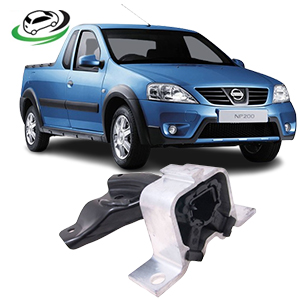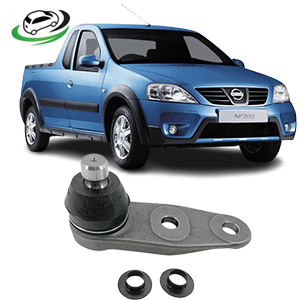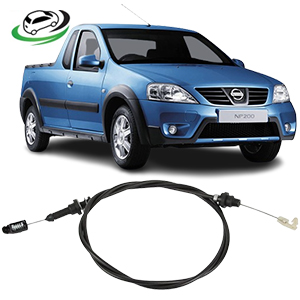-3%
Get Nissan Pick Up NP200 Wire Assy-Accelerator 18200-00Q0E
The Wire Assembly – Accelerator, commonly known as the throttle cable or accelerator cable, is a crucial component in a vehicle’s acceleration system. It connects the vehicle’s accelerator pedal to the throttle body or carburetor, ensuring smooth communication between the driver’s input and the engine’s response. In modern vehicles, the use of electronic throttle control systems (drive-by-wire) is more common, but many vehicles, particularly older models, still rely on this mechanical system. In this detailed explanation, we’ll explore its structure, function, working mechanism, types, maintenance, and the transition to electronic systems.
Structure of the Accelerator Wire Assembly
The wire assembly typically consists of the following parts:
- Outer Cable Sheath: This is a protective casing made of flexible rubber or plastic, sometimes reinforced with metal braiding. Its function is to protect the inner cable from external damage caused by environmental elements like dust, moisture, and heat, and also to provide the necessary rigidity to the assembly.
- Inner Wire: The core of the assembly is the actual wire that transfers the force from the accelerator pedal to the throttle. This wire is made of high-strength steel or braided wire to withstand tension and prevent snapping over time.
- Connectors and Fittings: These are the end points of the wire assembly, designed to attach the cable to both the accelerator pedal and the throttle body. These connectors ensure a secure, precise, and reliable fit.
- Adjuster Mechanism: Many throttle cables come equipped with an adjustment mechanism to fine-tune the tension in the wire, which is essential for ensuring proper response and operation.
Function of the Accelerator Wire Assembly
The primary function of the accelerator wire assembly is to relay the driver’s intent to accelerate the vehicle. When the driver presses the accelerator pedal, the wire pulls open the throttle valve in the throttle body (for fuel-injected vehicles) or the butterfly valve in a carburetor (for older models). This action increases the amount of air (and fuel, in carbureted engines) entering the engine, causing the engine to generate more power and propel the vehicle forward.
Working Mechanism of the Accelerator Wire
The accelerator wire assembly works through a simple pull-and-return mechanism:
- Depressing the Accelerator Pedal: When the driver presses the accelerator pedal, the inner cable is pulled, exerting tension. This pull is transmitted to the throttle valve, causing it to open and allow more air to flow into the engine’s intake manifold.
- Throttle Response: The engine control unit (ECU) in modern vehicles adjusts the fuel injection to match the increased air intake, boosting engine power. In carbureted systems, the throttle cable controls both air and fuel intake directly.
- Spring-Loaded Return: Once the accelerator pedal is released, a spring within the throttle body or carburetor pushes the throttle valve back to its original position. The tension in the cable is also released, and the pedal returns to its resting position.
Types of Accelerator Cables
There are generally two types of accelerator cables:
- Mechanical Accelerator Cable: This is the traditional type found in older vehicles, where a physical cable connects the pedal to the throttle body or carburetor.
- Electronic Throttle Control (Drive-by-Wire): Though not a “wire” in the traditional sense, the electronic throttle control uses sensors and actuators to replace the mechanical cable. Instead of pulling a cable, pressing the accelerator pedal sends an electrical signal to the throttle body, where an actuator adjusts the throttle valve.
Transition from Mechanical to Electronic Systems
In modern vehicles, the accelerator cable is being replaced by electronic throttle control (ETC) systems. This system, often referred to as “drive-by-wire,” eliminates the mechanical cable and replaces it with a system of sensors and actuators. The accelerator pedal in these systems has a position sensor that communicates with the engine control module (ECM). The ECM then adjusts the throttle valve electronically based on the pedal’s position.
This transition to electronic systems has several benefits:
- Increased Precision: Electronic systems offer greater precision in throttle control, allowing for smoother and more responsive acceleration.
- Better Fuel Efficiency: By precisely controlling the amount of air entering the engine, the ECU can optimize fuel consumption, improving overall efficiency.
- Integration with Other Systems: Electronic throttle control systems can be integrated with other systems, such as traction control, cruise control, and stability control, making them more versatile.
Advantages of Mechanical Accelerator Cables
Despite the shift toward electronic throttle control systems, mechanical accelerator cables still offer some advantages:
- Simplicity: Mechanical cables are simpler and easier to understand for technicians and vehicle owners. They can often be adjusted or replaced with basic tools, unlike electronic systems that require specialized equipment.
- Lower Cost: Mechanical accelerator cables are typically cheaper to manufacture and repair compared to electronic systems, which involve complex sensors and actuators.
- Reliability: Mechanical systems have fewer components that can fail, making them more reliable in certain situations. They are not susceptible to electronic malfunctions or software issues that can affect drive-by-wire systems.
Maintenance of Accelerator Wire Assemblies
Proper maintenance of the accelerator wire is essential for ensuring smooth vehicle operation and preventing sudden failure. Here are some key maintenance tips:
- Regular Inspection: The wire assembly should be inspected regularly for signs of wear, corrosion, fraying, or kinks. Any damage to the cable should be addressed immediately.
- Lubrication: Some accelerator cables require periodic lubrication to ensure smooth operation and reduce friction. Specialized lubricants designed for cable systems can be used to keep the inner wire moving freely.
- Adjustments: Over time, the cable may stretch or become loose, leading to slack in the system. Many accelerator cables come with adjustment mechanisms that allow you to tighten the cable for more precise throttle control.
- Replacement: Accelerator cables can wear out over time and should be replaced if they show significant signs of wear or if the throttle response becomes sluggish or erratic. It’s crucial to use a high-quality replacement cable that matches the vehicle’s specifications.
Signs of a Faulty Accelerator Wire Assembly
A failing accelerator cable can lead to various issues, including:
- Sluggish Throttle Response: If the cable becomes loose or frayed, you might notice a delay between pressing the accelerator pedal and the engine responding.
- Sticky or Stuck Pedal: A frayed or corroded cable can cause the accelerator pedal to stick, making it difficult to control the vehicle’s speed.
- Engine Revving Without Acceleration: In some cases, a broken or disconnected accelerator cable can cause the engine to rev without the vehicle moving forward, as the throttle is not opening properly.
- Complete Throttle Failure: If the cable snaps, the vehicle will lose the ability to accelerate, which could be dangerous in certain driving situations.
Conclusion
The Wire Assembly – Accelerator is a key component in older and some modern vehicles that rely on a mechanical throttle system. It plays an essential role in ensuring that the driver’s input is transmitted to the engine, allowing for smooth and responsive acceleration. While electronic throttle control systems are becoming the standard, many vehicles still use mechanical cables, especially in older models or in specific applications like motorcycles and performance vehicles. Regular maintenance and timely replacement of a damaged accelerator cable are crucial for safe and efficient vehicle operation.
Follow us on Facebook for more parts.



